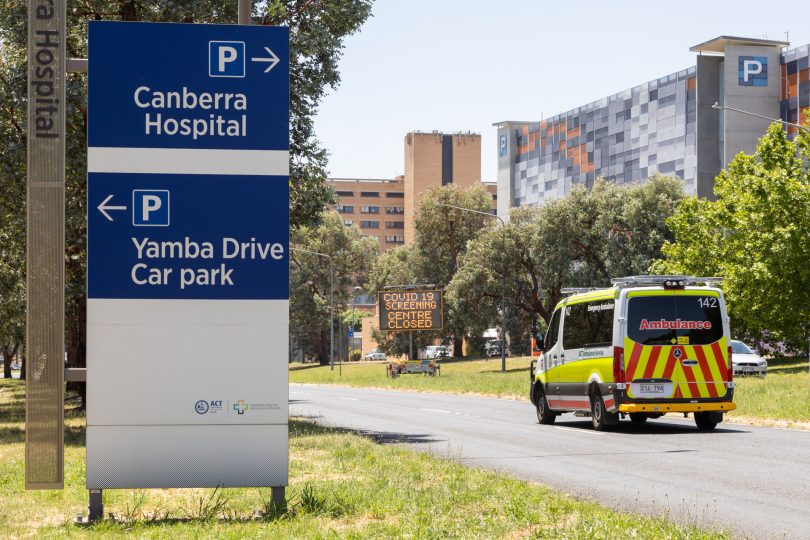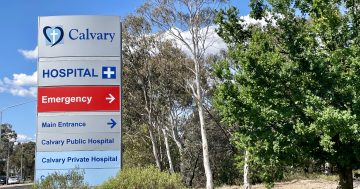
Some patients in the ACT have been waiting for an outpatients’ appointment for more than two years. Photo: Michelle Kroll.
Concerns about the wait time for a simple surgery to remove her son’s tonsils, adenoids and grommets has led to one Canberra woman seeking community funding to go through the private hospital system instead.
A spokesperson for Canberra Health Services confirmed the current average wait time for the 3199 people waiting for an outpatient appointment to be categorised is two years and five months.
When mother Sandy Winters-Scheerlinck learned of this, she decided it was unacceptably long.
Her son, Xander, suffers sleep problems, hearing loss, speech delays and behavioural issues because of problems associated with his tonsils, grommets and adenoids.
As a parent, she says it can be very stressful to hear three-year-old Xander struggling to breathe at night.
“The impact on his speech development has also been quite distressing,” says Sandy.
“Kids can be brutal and we didn’t want to have to wait until he started school.”

Three-year-old Xander suffers breathing, hearing and sleeping difficulties, as well as behavioral issues, because of his tonsils, adenoids and grommets. Photo: GoFundMe.
When Sandy first spoke to Canberra Hospital last year, she was advised of this two-year wait so made the decision to go private instead. Only six months after calling the ear, nose and throat (ENT) specialist, they had an appointment. Four weeks later, surgery was booked in.
Because Sandy was unwilling to wait, to get herself over the line financially she turned to a GoFundMe page.
“Initially, I was embarrassed to put up my hand for help, but once I received the final date for surgery I needed to get myself over the line for manageable borrowing,” she says.
Xander’s tonsils, adenoids and grommets were removed in a surgical procedure on 8 June. He is now recovering well, much to Sandy’s relief.
A spokesperson for Canberra Health Services (CHS) explained that wait times for such surgeries vary in line with clinical urgency. Urgent category-one cases are seen before others.
Once on the waitlist for ENT surgery, an acceptable wait-time is categorised as within 30 days for category one, 90 days for category two, and 365 days for category three.
Currently, the average wait time for category-one elective cases is between a few days and a few weeks, once seen by a specialist. The current median wait time for category two is 63 days, and for category three it’s 231 days.
However, before being categorised, patients must be seen at an outpatients’ appointment, the order of which is determined by the referral from the patient’s GP.
The spokesperson explained that COVID-19 impacted wait times because many non-urgent appointments were cancelled between March and June 2020.
Specifically, 105 tonsillectomies were delayed as a direct result of the cessation of non-essential surgery between March and June 2020 due to COVID-19.
Yet the ACT Government subsequently funded 107 tonsillectomies to take place in the private system, as well as an extra 56 to take place in extraordinary sessions at CHS.
According to the spokesperson, this has been helped by several CHS otolaryngology health and neck specialists who have committed time outside of their usual hours to assist, including on weekends and during holiday periods.
The ACT Government is also funding additional outpatient appointments in order to begin to clear the backlog of people waiting for these surgical procedures. As of early June 2021, more than 4000 additional outpatients appointments had been completed under this program.
In June 2020, there was a total of 428 people on the surgical waiting list. At April 2021, this number had dropped to 80.
Alongside COVID-19 related delays, the CHS spokesperson explained there is a high demand for operating theatres at Canberra Hospital, Calvary Public and private hospitals for emergency surgeries.
The impact of this flows on and affects the number of ear, nose and throat surgeries that can be performed each week in the ACT.
CHS recommends anyone who is waiting for elective surgery should contact their medical professional to seek advice from the Territory Wide Surgical Services team on 02 5124 9889.














